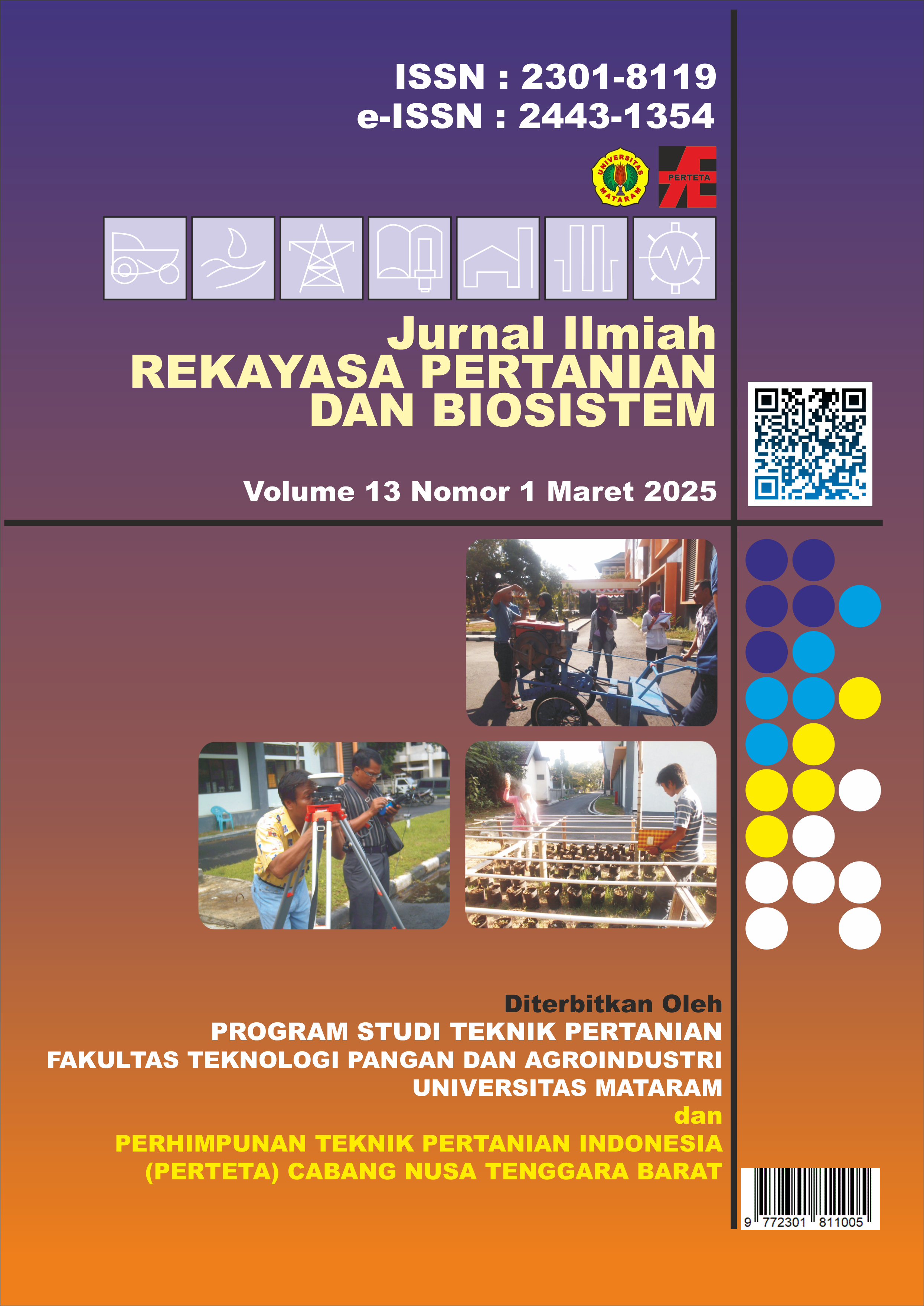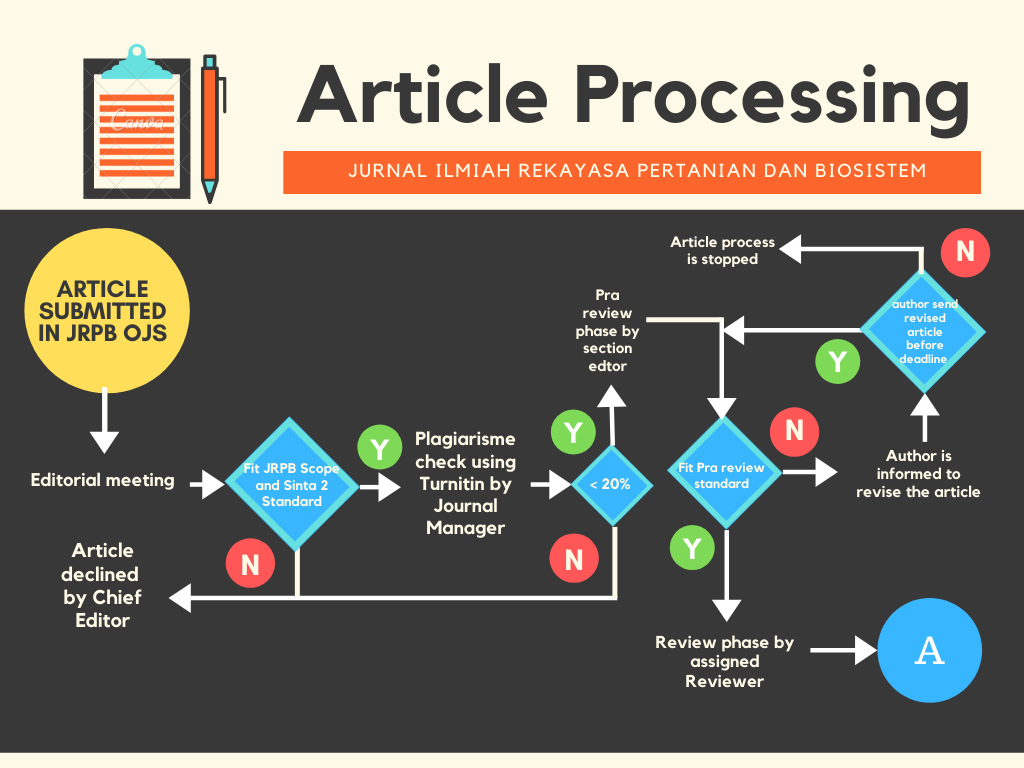Intermittent base automatic nutrient mixing design for urban farming dutch bucket melon cultivation system
Authors
I Dewa Made SubrataDOI:
10.29303/jrpb.v13i1.1156Published:
2025-03-27 — Updated on 2025-10-26Versions:
- 2025-10-26 (2)
- 2025-03-27 (1)
Issue:
Vol. 13 No. 1 (2025): Jurnal Ilmiah Rekayasa Pertanian dan BiosistemKeywords:
automation, dutch bucket, melon, nutrient mixing, urban farmingArticles
Downloads
How to Cite
Downloads
Abstract
This research aims to design an automatic nutrient mixing system for urban farming Dutch Bucket melon cultivation. The process of mixing nutrients for dutch bucket fertigation system begins by measuring the water level in the tank, then the raw water is flowed into the reservoir until it reaches the maximum height according to the set point. Next, the peristaltic pump is turned on for 300 ms and turned off for 2 s to supply A and B nutrient concentrations alternately until the TDS sensor reaches the set point value. The mixed nutrient solution is circulated continuously into the Dutch bucket and the nutrient runoff from the
Dutch bucket is flowed back into the reservoir. The research results show that the TDS sensor calibration has a root mean square error (RMSE) value of 28 ppm, the average sensor reliability error is 31,5 ppm and the maximum error is 87,4 ppm from three repetitions under the same conditions. The time required for mixing A
and B nutrient concentrations is 3 minutes. The average nutrient flow rate through the emitter pipe is 7,3 ml/s. The TDS sensor reading values are displayed on the LCD screen and also sent to the ThingSpeak cloud for monitoring purposes. The
overall test results provide the conclusion that the designed dutch bucket nutrient mixing and fertigation system is able to work well in melon cultivation for urban farming.
References
Agustin, R. D., Sucahyo, I., & Yantidewi, M. (2022). Rancang Bangun Alat Monitoring Pasang
Surut Air Laut Berbasis Iot Dengan Nodemcu ESP8266 dan HC-SR04. JIIF (Jurnal Ilmu
Dan Inovasi Fisika), 6(2), 147 – 157. https://doi.org/10.24198/jiif.v6i2.40345
Arrasyid, I., Masluki, & Arnama, I. N. (2024). Pengaruh Konsentrasi A-B Mix dan Frekuensi
Irigasi Tetes Hidroponik Duck Backet Terhadap Pertumbuhan dan Hasil Tanaman
Melon (Cucumis Melo L.). Wanatani, 4(2), 82–90.
https://pusdig.web.id/wanatani/article/view/306/348
Azam, I. A., Pujiharsono, H., & Indriyanto, S. (2023). Sistem Irigasi Tetes Menggunakan Sensor
Kelembapan Tanah Yl-69 Berbasis Internet Of Things (IoT). TEODOLITA : Media
Komunikasi Ilmiah Dibidang Teknik, 24(1), 65–73. https://doi.org/10.53810/jt.v24i1.477
Aziz, D. H. C., Razak, N. H., Zulkafli, N. I., Saat, S., & Tumari, M. Z. M. (2021). Automated
Fertilizer Blending System to Reduce Nitrogen Loss and Water Runoffs: A Best Evidence
Review. CHEMICAL ENGINEERING TRANSACTIONS, 89, 367–372.
https://doi.org/10.3303/CET2189062
Handayani, T., & Irawati, T. (2022). Efisiensi Sistem Irigasi Tetes (Drip Irrigation) Pada
Tanaman Melon Varietas Japonika. Jurnal Pertanian Agros, 24(2), 337–341.
https://doi.org/10.37159/jpa.v24i2.1939
Hutabarat, B. F., Peslinof, M., Afrianto, M. F., & Fendriani, Y. (2023). Sistem Basis Data
Pemantauan Parameter Air Berbasis Internet Of Things (Iot) Dengan Platform
ThingSpeak. Journal Online of Physics, 8(2), 42–50.
https://doi.org/10.22437/jop.v8i2.24365
Ikhwanusshofa, M., Nuramal, A., & Supardi, N. I. (2020). Pemanfaatan Internet Of Things
Untuk Monitoring Suhu Di Bppt–Meppo. Rekayasa Mekanik, 4(1), 19–24.
https://doi.org/10.33369/rekayasamekanika.v4i1.13274
Krisdiyantoro, S., Triyono, S., Tusi, A., & Haryanto, A. (2023). Optimasi Ukuran Pot dan Dosis
Pupuk pada Budidaya Melon (Cucumis melo L). Jurnal Agricultural Biosystem Engineering, 2(3), 419–427. https://doi.org/10.23960/jabe.v2i3.8052
Kuala, S. I., Susanti, N. D., Siregar, Y. H., Haryanto, A., & Basuki, G. R. (2021). Rancang
Bangun, Uji Performansi dan Analisis Biaya Alat Pencampur Nutrisi. TEKNIK, 42(1), 1–
https://doi.org/10.14710/teknik.v42i1.24800
Kurniasari, L., Azizah, M., Cahyaningrum, D. T., Rohman, F., & Dinata, G. F. (2023). Response
of growth and production of melon (Cucumis melo L. var. inodorous) on different
concentrations of AB mix fertilizer and gibberellin in tefa smart green house polije. IOP
Conference Series: Earth and Environmental Science, 1168 01201, 1–6.
https://doi.org/10.1088/1755-1315/1168/1/012011
Manuhara, Y. S. W., Kristanti, A. N., Sugiharto, Sugiarso, R. D., Putro, Y. K., & Yudha, A. W.
(2022). Empowerment Of Youth Community In Poso Regency, Through Produce Tomato
And Melon By Hydroponic System. Darmabakti Cendekia : Journal of Community Service
and Engagements, 4(1), 8–15. https://doi.org/10.20473/dc.V4.I1.2022.8-15
Minarni, E. W., & Ulinnuha, Z. (2023). Pengaruh Perbedaan Jarak Tanam terhadap
Pertumbuhan dan Kualitas Melon pada Sistem Hidroponik NFT. Agritech: Jurnal IlmuIlmu Pertanian, 25(1), 145–151. https://doi.org/10.30595/agritech.v25i1.17045
Negara, I. D. G. J., Hanifah, L., Supriyadi, A., Pradjoko, E., & Pracoyo, A. (2023). Analisis
Optimasi Aplikasi Sistem Irigasi Tetes PVC Ber-Amiter pada Variasi Lahan Bertingkat
Untuk Mendukung Kegiatan Pertanian di Permukiman Perkotaan. Jurnal Sains Teknologi
& Lingkungan, 9(3), 401–412. https://doi.org/10.29303/jstl.v9i3.490
Nora, S., Yahya, M., Mariana, M., Herawaty, H., & Ramadhani, E. (2020). Teknik Budidaya
Melon Hidroponik dengan Sistem Irigasi Tetes (Drip Irrigation). AGRIUM: Jurnal Ilmu
Pertanian, 23(1), 21–26. https://doi.org/10.30596/agrium.v23i1.5654
Pertiwi, A., Kristianti, V. E., Jatnita, I., & Daryanto, A. (2021). Sistem Otomatisasi Drip Irigasi
Dan Monitoring Pertumbuhan Tanaman Cabai Berbasis Internet Of Things. Sebatik, 25(2),
–747. https://doi.org/10.46984/sebatik.v25i2.1623
Rafida, S. N., Mura, M. R., Ferryanto, A., Fatikhaturrohmah, A., Aditya, D. S., & Sayekti, I.
(2023). Penerapan Teknologi Smart Farming Berbasis Internet Of Things Untuk
Meningkatkan Kualitas Melon Madu Di Agrowisata Purwosari. ORBITH, 19(3), 263–272.
https://doi.org/10.32497/orbith.v19i3.5254
Rouhillah, Salfikar, I., & Ichsan, M. (2022). Kontrol Nutrisi Tanaman HidroponikBerbasis
MonitoringInternet of Things. Elektron Jurnal Ilmiah, 14(2), 72–77.
https://doi.org/10.30630/eji.14.2.306
Saydi, R., Fanata, W. I. D., Ristiyana, S., & Saputra, T. W. (2022). Pengaruh Variasi Media
Tanam Dan Dosis Nutrisi Ab Mix Terhadap Pertumbuhan Dan Hasil Tanaman Tomat
(Solanum Lycopersicum L.) Dengan Hidroponik Sistem Dutch Bucket. Jurnal Agrotek
Tropika, 10(4), 607–614. https://doi.org/10.23960/jat.v10i4.6061
Septya, F., Rosnita, R., Yulida, R., & Andriani, Y. (2022). Urban Farming Sebagai Upaya
Ketahanan Pangan Keluarga Di Kelurahan Labuh Baru Timur Kota Pekanbaru. Reswara :
Jurnal Pengabdian Kepada Masyarakat, 3(1), 105–114.
https://doi.org/10.46576/rjpkm.v3i1.1552
Sipayung, A. R., Andromeda, T., & Afrisal, H. (2020). Perancangan Sistem Monitoring Dan
Pengendalian Nutrisi Pada Tanaman Hidroponik Sistem Nutrient Film Technique (NFT)
Menggunakan Kontrol PID. TRANSIENT: Jurnal Ilmiah Teknik Elektro, 9(4), 564–573.
https://doi.org/10.14710/transient.v9i4.564-573
Supriyanta, B., Mangaras, & Widowati, I. (2022). Budidaya Melon Hidroponik Dengan Smart
Farming (2022nd ed.). Lembaga Penelitian dan Pengabdian Kepada Masyarakat UPN
“Veteran” Yogyakarta. http://eprints.upnyk.ac.id/32893/1/Buku_ BUDIDAYA
MELON HIDROPONIK DENGAN SMART FARMING_Bambang
Supriyanta_monev3.pdf
Suryatini, F., Pancono, S., Bhaskoro, S. B., & Muljono, P. M. S. (2021). Sistem Kendali Nutrisi
Hidroponik berbasis Fuzzy Logic berdasarkan Objek Tanam. ELKOMIKA: Jurnal Teknik
Energi Elektrik, Teknik Telekomunikasi, & Teknik Elektronika, 9(2), 263–278.
https://doi.org/10.26760/elkomika.v9i2.263
Toruan, P. L., Margareta, B., Jumarni, A., Pratiwi, S. S., & Atina. (2023). Pengaruh Temperatur
Air Terhadap Konduktivitas dan Total Dissolved Solid. Jurnal Kumparan Fisika, 6(1), 11–
https://doi.org/10.33369/jkf.6.1.11-16
Wahyuni, S., Wahyudi, M., & Rusidy, A. (2021). Rekayasa Digitalisasi Pertanian Hidroponik
NFT dengan Model Kendali Suhu, pH dan Electrical Conductivity (EC). Rekayasa, 14(1),
–77. https://doi.org/10.21107/rekayasa.v14i1.9217
Yanti, N. T., Juwanda, M., Adita, M. D., & Khotimah, K. (2022). Analisis Keuntungan Usaha
Tani Buah Melon Desa Banjaratma Kabupaten Brebes. Journal of Agribusiness and
Community Development (AGRIVASI), 2(1), 139–148.
License
Copyright (c) 2025 I Dewa Made Subrata

This work is licensed under a Creative Commons Attribution-ShareAlike 4.0 International License.
Authors who publish with this journal agree to the following terms:
- Authors retain copyright and grant the journal right of first publication with the work simultaneously licensed under a Creative Commons Attribution License 4.0 International License (CC-BY-SA License). This license allows authors to use all articles, data sets, graphics, and appendices in data mining applications, search engines, web sites, blogs, and other platforms by providing an appropriate reference. The journal allows the author(s) to hold the copyright without restrictions and will retain publishing rights without restrictions.
- Authors are able to enter into separate, additional contractual arrangements for the non-exclusive distribution of the journal's published version of the work (e.g., post it to an institutional repository or publish it in a book), with an acknowledgement of its initial publication in Jurnal Ilmiah Rekayasa Pertanian dan Biosistem (JRPB).
- Authors are permitted and encouraged to post their work online (e.g., in institutional repositories or on their website) prior to and during the submission process, as it can lead to productive exchanges, as well as earlier and greater citation of published work (See The Effect of Open Access).










